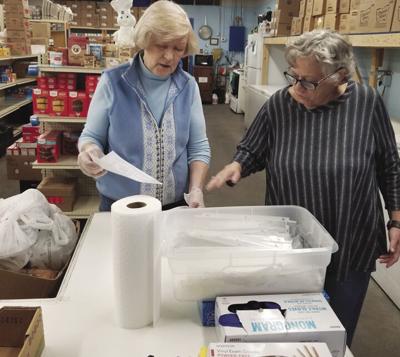LACONIA – Since November, the New Hampshire Food Bank has operated a mobile food pantry in Laconia – a drive-through pick-up for 33-pound boxes of produce, dairy and stable meats such as hot dogs and cooked chicken – for roughly 400 families a week who have collected them on Tuesdays from trucks parked at Lakes Region Community College and Laconia Middle School.
It’s been part of the food bank’s successful food-to-family delivery service that travels to locations statewide from Keene to Colebrook, said Nancy Mellitt, development director for NH Food Bank, which is administered by NH Catholic Charities. “Our intent is while the pandemic continues and there is a need, we will continue,” Mellitt said.
Set to resume next week after a winter break, with pickup locations to be determined, the mobile pantry adds to a modest bounty of free food sources that are available to the area’s neediest. Many don’t require proof of income and are a boon to families that have been hit hard during the pandemic by wage losses, and increased food expenses for children who have previously gotten free or low-cost breakfast and lunch at school.
For those with limited means to cover life’s basics, getting enough to eat has often involved a hopscotch trek between local charities and social services. Families rotate between grocery pickups at food pantries and hot meals-to-go from local nonprofits, including those with religious ties, depending on the day and week. It’s a system that works for many. But it also depends on having transportation, or someone to deliver the food – which are important links in the chain.
At this point in the pandemic, Lakes Region food providers say it’s hard to know if local families, especially those with children, are getting enough. Since the summer, some outlets have seen a drop in customers – and usage is far less than a year ago.
Some service providers, including Jo Carrignan, director of the St. Vincent DePaul Society in Laconia, worry that stimulus checks are being spent on non-essentials – and not on rent or fuel, and possibly on less healthful food and beverages, when nutritious food is available for free – but there’s no way to tell. Some, like Mellitt, wonder if COVID’s social distancing and mounting contagion fears are driving down conventional food pantry use in longstanding locations.
The mobile pantry may be impacting brick-and-mortar pantry use in some of the towns and cities it serves, Mellitt said. From the Comcast parking lot in Manchester, the NH Food Bank passes out over 900 boxes a week. According to the Food Bank, the demand for free food across the state has increased by close to 40 percent since March, largely because of the pandemic’s effect on employment and food security.
The St. Vincent de Paul food pantry in Laconia, which now uses a socially distanced version of pickup at its location on Union Avenue, has seen a drop of at least 25 percent in use – a decline from about 400 to 300 families a month, from the same time last year. Carrignan said she misses seeing the families the society has served like clockwork for years, and is especially worried about the children.
“We don’t throw anything away. The government has bought so much food for organizations. We can save canned goods. But we have so much fresh produce and fresh bread,” Carrignan said. “It’s a shame people aren’t taking advantage of this. Clients who have been with us for years have stopped showing up. You would think the demand would be so much greater.”
Carrignan, who has worked at the pantry for 30 years, says they've never experienced a drop like this – and the reasons are a puzzle.
The pantry is open Monday from 12-2 p.m., and Wednesday from 6-8 p.m., and the pickup process is safe and simple, designed to be as COVID-proof as possible, Carrignan said. Families fill out a form, checking off what they need, and are only required to give names and ages of the people in their household. The information is confidential. Inside the pantry, volunteers fill boxes and place them outside the garage door for families waiting in cars.
“They’re not in contact with any of us,” Carrignan said. “It’s a simple way to get fresh food” – much of it coming from local grocery stores, including Hannaford, Shaw’s and Vista Foods. “We’re trying to get people to take advantage of this so they’ll have more money for other essentials,” she said. Because of COVID, “everybody’s broke at their own level.”
The Laconia Salvation Army has also witnessed a significant decline in numbers served by its food pantry and soup kitchen (now operating as a drive- or walk-up takeout), which have been mainstays for struggling families for decades, according to Major Mike Davis, co-leader of the Laconia unit.
Although the presence on Tuesdays of the NH Food Bank’s mobile pantry could be a factor in reducing demand at other outlets, it’s tough to know why there could be such a fall off during tight, uncertain times – which are lasting longer than most providers and families anticipated.
“There are so many questions and no answers,” Carrignan said. “It’s food. It’s an essential. They have to be getting it somewhere. I’m concerned about their lack of good food,” and having enough on shelves at home.
Because of COVID, the Laconia Boys and Girls Club reduced its indoor meal seating for children in its after-school program by about 40 percent, in compliance with social distancing and hygiene guidelines, said Jim Holmes, branch director of the Boys and Girls Club of the Lakes Region. Pickup of free to-go dinners Monday through Friday peaked at the end of summer to early fall, Holmes said, and has since declined from 90 to 120 meals a night and sometimes as many as 160 – to about 70 to 80 nightly, depending on the popularity of the menu, which is listed online.
The biggest draw continues to be barbecued chicken, which still serves over 100. At the weekday pick-up from 4 to 5:30 p.m., some cars collect one meal, others up to 10. The club still cooks the same amount of food daily and leftovers are collected by regulars who distribute them to others in need, including homebound elders and people who don’t drive, Holmes said.
Out of the Boys and Girl’s Clubs of Central New Hampshire’s three locations in Allenstown, Concord and Laconia, the Lakes Region club has proven over time to be the one with the highest consistent demand, said executive director Chris Emond.
Use of the Meredith Food Pantry, meanwhile, has held steady during the pandemic, serving roughly 200 households in Meredith, New Hampton and Center Harbor, without a drop in numbers. “Knock on wood. We haven’t had any issues yet,” said pantry director Barbara Rayno.
The continued success and utilization of community food pantries may be even more critical in the future.
The pandemic – which affected employment, transportation, and labor and the supply chains, coupled with weather issues, tariffs, and fluctuations in worldwide harvest levels – has put pressure on an already-strained worldwide food supply.
According to the United Nations Food & Agriculture Organization, global food prices have climbed by 18 percent since May. The FAO’s food price index has risen steadily for several months, posting the highest annual average in three years, though still well below rocketing food costs in 2008 and 2011, which sparked economic and political instability, according to the FAO.
According to UN data cited by Bloomberg.com last week, global food prices hit a six-year high last month and are expected to continue to increase through 2021. Historically, ballooning costs of things to eat have the greatest effect on the poor, whose diets are often less nutritious and dependable than those of even slightly more well-off people, who have a greater financial cushion for buying food.
The NH Food Bank distributes staples to the state’s pantries from the U.S. government’s Farm to Families program. Produce, dairy and meats now come from a large producer in Maryland, Mellitt said.
Half of what state charities and service agencies hand out comes through the Food Bank, and the volume sent to pantries rose by nine percent in 2020, Mellitt said. The balance of what food pantries have to offer comes from supermarkets, and is purchased with donations from local businesses and residents – sources that are also subject to financial strain.
During the pandemic, the Belknap-Merrimack Community Action Program, which provides a variety of services to needly households – including rent and fuel assistance, and monthly bags of USDA food from the food bank – has witnessed an increase in demand across all forms of its assistance, said president Jeanne Agri.
Providers wonder if weekly pantry use is stymied by transportation issues, and household availability during pick up hours.
“I wish there were a way to bring meals around, but it’s not something we can do now,” said Holmes at the Boys and Girls Club. “I’m concerned that people aren’t able to get to the club sometimes, and that’s prohibiting them from getting meals. Maybe the need has decreased as the community has gotten used to operating during COVID. My hope is that businesses and the community have adapted to the COVID world. At least that’s my hope.”
“It’s tough to know," he said. "We see a decent amount of regular families some to pick up, but not as many as we’d like. I hope they’re doing OK.”


















(0) comments
Welcome to the discussion.
Log In
Keep it Clean. Please avoid obscene, vulgar, lewd, racist or sexually-oriented language.
PLEASE TURN OFF YOUR CAPS LOCK.
Don't Threaten. Threats of harming another person will not be tolerated.
Be Truthful. Don't knowingly lie about anyone or anything.
Be Nice. No racism, sexism or any sort of -ism that is degrading to another person.
Be Proactive. Use the 'Report' link on each comment to let us know of abusive posts.
Share with Us. We'd love to hear eyewitness accounts, the history behind an article.